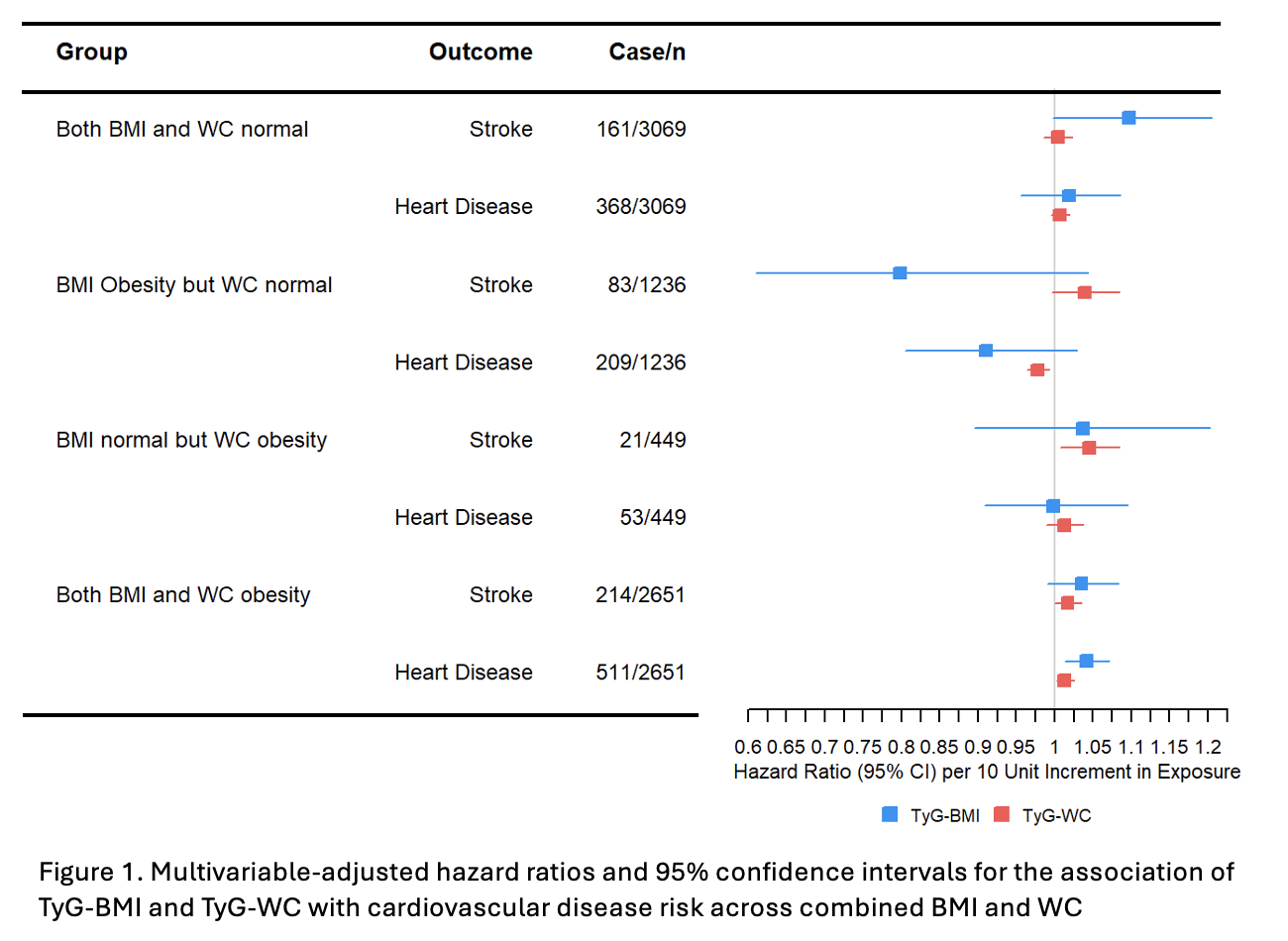Final ID: P3040
Associations between Triglyceride-glucose-obesity Indicators with Cardiovascular Disease Across Combination of Body Mass Index and Central Obesity Categories: The China Health and Retirement Longitudinal Study
Abstract Body: Introduction
The triglyceride glucose-body mass index (TyG-BMI) and triglyceride glucose-waist circumference (TyG-WC) are fast and simple clinical indices with proven reliability in predicting heart diseases and stroke. Considering the obesity paradox, where body mass index (BMI) may fail to accurately predict cardiovascular outcomes in obese patients, assessing the effectiveness of TyG-BMI and TyG-WC across the combination categories of BMI and waist circumference (WC) becomes essential.
Methods
We included individuals with complete data on TyG, fasting plasma glucose, BMI, and WC at 2011 wave. Incidence of heart disease and stroke was observed during the follow-up visits. All participants were classified into four groups at baseline: both BMI and WC normal, BMI obesity (BMI ≥ 24 kg/m2) but WC normal, BMI normal but WC obesity (WC, male ≥ 90 cm, female ≥ 80 cm) and both BMI and WC obesity. TyG-BMI and TyG-WC were calculated as BMI * TyG index and WC * TyG index, where TyG index = ln[FPG (mg/dL) * TG (mg/dL)/2]. Multivariate Cox proportional hazards models were employed to assess the association between TyG-BMI and TyG-WC with the risk of incident cardiovascular disease within the four groups, adjusted for demographic characteristics, smoking, drinking, blood urea nitrogen, high-density lipoprotein cholesterol, low-density lipoproteins cholesterol, C-Reactive protein, hemoglobin, uric acid, serum creatinine, cystatin C, hypertension, diabetes and kidney disease.
Results
Among 7,405 participants (mean age 57.8, 53.9% women), 479 stroke and 1141 heart disease incidents were recorded with average follow-up years of 6.55 and 6.35. The fully adjusted models in Figure 1 revealed that in the BMI and WC obesity group, every 10-unit increase in TyG-BMI and TyG-WC was associated with 4.2% and 1.3% higher risk of heart disease respectively (HR = 1.04, 95% CI = 1.01, 1.07; HR = 1.01, 95% CI = 1.002, 1.03). Additionally, among individuals with normal BMI but obese WC, each 10-unit rise in TyG-WC was associated with a 4.5% increase in stroke risk (HR = 1.05, 95% CI = 1.01, 1.08).
Conclusions
The TyG-BMI and TyG-WC indices exhibit differential predictive capabilities for cardiovascular disease risk across diverse obesity phenotypes, where the applicability could not extend to populations characterized by both normal BMI and WC. Our findings stress the importance of applying TyG indices to tailored populations, enhancing the precision of cardiovascular risk assessment.
The triglyceride glucose-body mass index (TyG-BMI) and triglyceride glucose-waist circumference (TyG-WC) are fast and simple clinical indices with proven reliability in predicting heart diseases and stroke. Considering the obesity paradox, where body mass index (BMI) may fail to accurately predict cardiovascular outcomes in obese patients, assessing the effectiveness of TyG-BMI and TyG-WC across the combination categories of BMI and waist circumference (WC) becomes essential.
Methods
We included individuals with complete data on TyG, fasting plasma glucose, BMI, and WC at 2011 wave. Incidence of heart disease and stroke was observed during the follow-up visits. All participants were classified into four groups at baseline: both BMI and WC normal, BMI obesity (BMI ≥ 24 kg/m2) but WC normal, BMI normal but WC obesity (WC, male ≥ 90 cm, female ≥ 80 cm) and both BMI and WC obesity. TyG-BMI and TyG-WC were calculated as BMI * TyG index and WC * TyG index, where TyG index = ln[FPG (mg/dL) * TG (mg/dL)/2]. Multivariate Cox proportional hazards models were employed to assess the association between TyG-BMI and TyG-WC with the risk of incident cardiovascular disease within the four groups, adjusted for demographic characteristics, smoking, drinking, blood urea nitrogen, high-density lipoprotein cholesterol, low-density lipoproteins cholesterol, C-Reactive protein, hemoglobin, uric acid, serum creatinine, cystatin C, hypertension, diabetes and kidney disease.
Results
Among 7,405 participants (mean age 57.8, 53.9% women), 479 stroke and 1141 heart disease incidents were recorded with average follow-up years of 6.55 and 6.35. The fully adjusted models in Figure 1 revealed that in the BMI and WC obesity group, every 10-unit increase in TyG-BMI and TyG-WC was associated with 4.2% and 1.3% higher risk of heart disease respectively (HR = 1.04, 95% CI = 1.01, 1.07; HR = 1.01, 95% CI = 1.002, 1.03). Additionally, among individuals with normal BMI but obese WC, each 10-unit rise in TyG-WC was associated with a 4.5% increase in stroke risk (HR = 1.05, 95% CI = 1.01, 1.08).
Conclusions
The TyG-BMI and TyG-WC indices exhibit differential predictive capabilities for cardiovascular disease risk across diverse obesity phenotypes, where the applicability could not extend to populations characterized by both normal BMI and WC. Our findings stress the importance of applying TyG indices to tailored populations, enhancing the precision of cardiovascular risk assessment.
More abstracts on this topic:
A Cardiac Ryanodine Receptor C-terminal Truncation Causes Calcium Release Deficiency Syndrome, but not Catecholaminergic Polymorphic Ventricular Tachycardia
Tian Shanshan, Ni Mingke, Wang Hui, Zhu Hai-lei, Wang Ruiwu, Estillore John Paul, Chen Wayne
A Metabolomic Study of Cardiac Dysfunction in HyperglycemiaYoshida Yilin, Qi Qibin, Cheng Susan, Kaplan Robert, Rodriguez Carlos, Shah Amil, Yu Bing, Nguyen Ngoc Quynh, Moon Eun Hye, Casey Rebholz, Skali Hicham, Arthur Victoria, Echouffo Justin, Ballantyne Christie, Selvin Elizabeth

